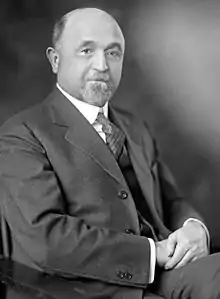| Humphrey's Executor v. United States | |
|---|---|
 | |
| Argued May 1, 1935 Decided May 27, 1935 | |
| Full case name | Humphrey's Executor v. United States Rathbun, Executor v. United States |
| Citations | 295 U.S. 602 (more) 55 S. Ct. 869; 79 L. Ed. 1611; 1935 U.S. LEXIS 1089 |
| Holding | |
| The President may not remove an appointee to an independent regulatory agency except for reasons that Congress has provided by law. | |
| Court membership | |
| |
| Case opinion | |
| Majority | Sutherland, joined by unanimous |
| Laws applied | |
| U.S. Const. art. I; U.S. Const. art. II; Federal Trade Commission Act | |
Humphrey's Executor v. United States, 295 U.S. 602 (1935), was a Supreme Court of the United States case decided regarding whether the United States President has the power to remove executive officials of a quasi-legislative or quasi-judicial administrative body for reasons other than what is allowed by Congress. The Court held that the President did not have this power. However, Humphrey's has been distinguished by Seila Law LLC v. Consumer Financial Protection Bureau. In Seila, Chief Justice John Roberts described Humphrey's as holding that Congress may occasionally create independent agencies with removal only for cause if such agencies share the characteristics of the FTC in 1935.
Background
President Calvin Coolidge appointed William Humphrey as a member of the Federal Trade Commission (FTC) in 1925, and Humphrey was reappointed for another six-year term in 1931. After Roosevelt took office in 1933, he became dissatisfied with Humphrey and viewed him as inadequately supportive of the New Deal.[1]
Roosevelt twice requested Humphrey to resign from the FTC, but Humphrey did not yield. Finally, in 1933 Roosevelt fired Humphrey. Nevertheless, Humphrey continued to come to work at the FTC even after he was formally fired.[1] However, the Federal Trade Commission Act permitted the President to dismiss an FTC member only for "inefficiency, neglect of duty, or malfeasance in office." Roosevelt's decision to dismiss Humphrey was based solely on political differences, rather than job performance or alleged acts of malfeasance.[2]
Decision
The case went to the Supreme Court, but Humphrey died in 1934 before the case could be decided. The case was then pursued by the executors of his estate and so it obtained the title "Humphrey's Executor."[2]
The Court distinguished between executive officers and quasi-legislative or quasi-judicial officers. The Court held that the latter may be removed only with procedures consistent with statutory conditions enacted by Congress, but the former serve at the pleasure of the President and may be removed at his discretion. The Court ruled that the Federal Trade Commission was a quasi-legislative body because it adjudicated cases and promulgated rules. Thus, the President could not fire a member solely for political reasons. Therefore, Humphrey's firing was improper.[2]

During its analysis, the Court distinguished Myers v. United States and rejected its dicta that the President has unencumbered removal powers.[3]
Aftermath
US Attorney General Robert H. Jackson, who later joined the Supreme Court himself, stated in his memoirs that Roosevelt was particularly annoyed by the Court's decision and felt that it had been rendered in spite.
Humphrey's was distinguished in Seila Law LLC v. Consumer Financial Protection Bureau (2020)[4] in which Chief Justice Roberts narrowly construed Humphrey's[5] to stand for the proposition that the President's removal power may be constrained by Congress if the officer in question was a member of an agency that shared the same characteristics as the Federal Trade Commission in 1935.[4] However, scholars argue that no such agency currently exists because none existed when Humphrey's was decided since the Court misconstrued the FTC's powers at the time.[3][5]
See also
- The Appointments Clause of the U.S. Constitution
- Shurtleff v. United States, 189 U.S. 311 (1903) ("In the absence of constitutional or statutory provision, the President can, by virtue of his general power of appointment, remove an officer, even though he were appointed by and with the advice and consent of the Senate.").
- Myers v. United States, 272 U.S. 52, 53 (1926) ("The President is empowered by the Constitution to remove any executive officer appointed by him by and with the advice and consent of the Senate, and this power is not subject in its exercise to the assent of the Senate, nor can it be made so by an act of Congress.").
- Bowsher v. Synar, 478 U.S. 714 (1986) ("In light of these precedents, we conclude that Congress cannot reserve for itself the power of removal of an officer charged with the execution of the laws except by impeachment.").
- Morrison v. Olson, 487 U.S. 654, 675 (1988) ("[T]here was little or no debate on the question whether the Clause empowers Congress to provide for interbranch appointments, and there is nothing to suggest that the Framers intended to prevent Congress from having that power.").
- Seila Law LLC v. Consumer Financial Protection Bureau, 591 U.S. ____ (2020)
- List of United States Supreme Court cases, volume 295
References
- 1 2 McKenna, Marian C. (2002). Franklin Roosevelt and the Great Constitutional War: The Court-Packing Crisis of 1937. Fordham University Press. pp. 96–99. ISBN 0-8232-2154-7.
- 1 2 3 Humphrey's Executor v. United States, 295 U.S. 602 (1935).
- 1 2 Mashaw, Seila (August 27, 2020). "Of Angels, Pins, and For-Cause Removal: A Requiem for the Passive Virtues". The University of Chicago Law Review Online. Retrieved November 30, 2021.
- 1 2 Seila, 140 S. Ct. at 2199–200.
- 1 2 Sitaraman, Ganesh (2020). "The Political Economy of the Removal Power". Harvard Law Review. 134: 381.
External links
 Works related to Humphrey's Executor v. United States at Wikisource
Works related to Humphrey's Executor v. United States at Wikisource- Text of Humphrey's Executor v. United States, 295 U.S. 602 (1935) is available from: Cornell CourtListener Google Scholar Justia Library of Congress